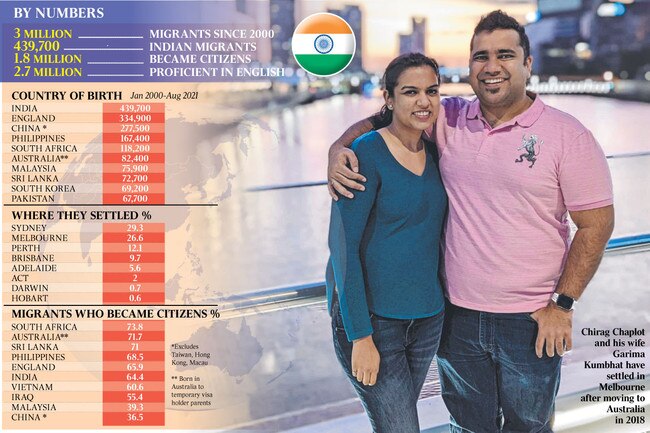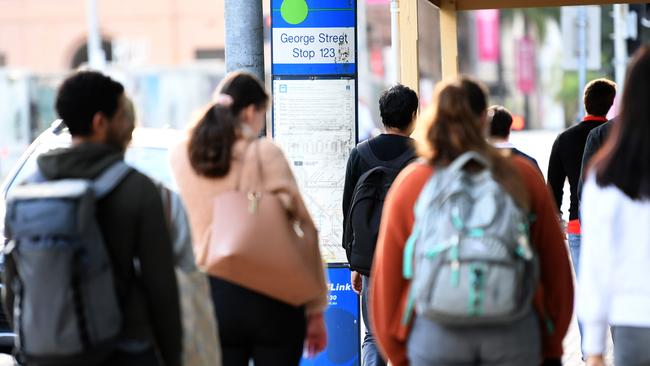Australia must target the most skilful migrants to get the full benefit of foreign workers
Sweeping reforms are needed to the complex visa system to attract the most skilful employees if Australia is to capture the full potential of migration, a new study has found.

Productivity dividends from overseas workers are perishing over time, suggesting sweeping reforms are needed to the complex visa system to attract the most skilful employees if Australia is to capture the full potential of migration, a new study has found.
Researchers from the e61 Institute said the benefits of immigration fell in the decade before the pandemic because foreign workers are increasingly likely to be employed in low productivity industries, such as hospitality and administration, and by “zombie” firms.
The first study of the link between migrants and the productivity of local firms, published on Wednesday evening, shows the economy’s ability to divert scarce workers from lagging to leading firms has deteriorated.

Migrants targeted for skills are good for productivity, while untargeted migrants such as students and working holiday makers yield lower returns.
E61’s research director and study co-author Dan Andrews said the nation “has a productivity problem and we’ve been using immigration to cover it up”.
“A bigger Australia brings many benefits but the boon to living standards gets depleted when productivity is left to stagnate,” Mr Andrews said.
“Rather than adding much needed grease, the pre-pandemic migration boom threw grit into the wheels of the creative destruction machine that channels workers towards more productive firms.
“In an uber-competitive global labour market, the challenge for migration policy is no longer just to get bums on seats, but to get the right bums on the right seats.”
The study comes amid a record migration surge, driven by the return of students, temporary workers and permanent migrants after the end of Covid-related border closures and a six-decade low in productivity growth.

The Albanese government is considering the findings of a broad migration review by a three-person expert panel, while later this year Treasury will present an Employment White Paper to drive better labour market outcomes.
This month, a five-yearly review of productivity by the Productivity Commission said skilled migration needed to be improved to extract a greater economic dividend from migration.
The commission called for an overhaul of temporary work visas, including the ditching of occupational lists, and more emphasis on the market rationing skilled migration.
In the decade studied by e61, annual net overseas migration averaged 216,000, compared with 165,000 in the preceding ten years.
Migration accounted for 56 per cent of population growth this century, with students and permanent migrant workers responsible for an increase in the migrant share of workers from 12 to 16 per cent over the decade.
“This population increase drove a wedge between growth in GDP and GDP per capita, concealing a pronounced slowdown in productivity growth,” e61 said.
“This slowdown appears to be underpinned by important changes at the micro-economic level, including a decline in the reallocation of workers from less productive to more productive firms.”

With the economy at full employment, exposing skills gaps, employers have called for a higher number of permanent migrants.
The Albanese government raised the permanent migration cap from 160,000 to 195,000 for this financial year and has cleared much of a pandemic-era visa backlog.
The e61 researchers were able to access a unique data set, allowing them to provide fresh evidence on the types of firms that employ migrants and how this has changed over time.
The probability of a company employing at least one migrant worker increases with firm size, partly reflecting the fixed costs of hiring migrant workers, which can be absorbed by scale.
E61 said the productivity slowdown may reflect declines over time in the ability levels of new migrants; the matching efficiency of migrant workers to firms; or the characteristics of the firms that employ migrant workers.
“Regardless, immigration appears relevant for understanding the declining propensity for high productivity firms to expand and low productivity firms to contract,” the study said.
“Concerningly, both targeted and untargeted migrant workers have become more likely to work at lower productivity firms over time.
“This trend may be driven by changes in the types and abilities of migrants within visa types, or the types of firms seeking out workers from these visa classes.”
E61 said one potential explanation for the decline in how migrants are allocated across productive firms over time is that “the relative quality of migrant workers coming to Australia has decreased”.
“Qualitative evidence from firms that engage regularly with Australia’s visa system highlighted that the system has become harder to navigate over time, with lengthy processes making it harder to compete for skilled workers in an increasingly competitive and global labour market.
“Encouragingly, workers on more targeted visas (permanent and temporary skilled) allocate to more productive firms than non-migrant workers, highlighting the economic benefits of more targeted and skilled migration.
“However, our untargeted grouping of visas (student and working holiday maker visa holders) are increasingly likely to work in less productive firms.
“This raises questions about these visa types, including whether the work restrictions we place on them have unintended negative economic consequences through limiting their bargaining power in the labour market, and whether those restrictions are still relevant in today’s economy.”
E61 said further work should also explore the relative productivity impact of skilled local workers versus targeted migrant workers.
“Australia’s migration system is highly complex, with over 100 different visas, and has not undergone major structural reform for decades,” the study said.
“The federal government’s focus on reforming the migration program means that the time is right for evidence-driven policy making.”
The study said while Australian immigration researchers have largely focused on the population and labour market impacts, international studies have found positive effects of migrants on firm productivity, and local workers’ wages and employment
Last year a New Zealand analysis showed that skilled and long-term migrants made above-average contributions to firm output, whereas lower skilled migrants made smaller contributions.







To join the conversation, please log in. Don't have an account? Register
Join the conversation, you are commenting as Logout